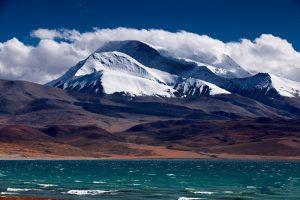
Seguochamu Monastery in Xaitongmoin County, Shigatse
Chinese Name: 谢通门县色果查姆寺
English Name: Seguochamu Monastery
Location: Located at the Nainang Village(乃囊村) of Tading Township(塔丁乡)
Admission Fee: Free
Opening Hours: All the day
About Seguochamu Monastery (色果查姆寺)
Seguochamu Monastery (色果查姆寺) is located at the Nainang Village(乃囊村) of Tading Township(塔丁乡), east of the Xaitongmoin County (84 km away from the city of Shigatse). The monastery borders Puqu River(仆曲河) in the west, Dongrijia Mountain(东日嘉山) in the east, connected with the Sejie Monastery(色结寺) of the mountain to form a whole part of Bonism(苯教). The monastery was built in 1161, and was founded by the descendant of Muxin(木辛), Hinton Yisirozhuo(辛顿·益西罗卓), is a family monastery of the Xincang Family(辛仓家族).
Architectural Style
The Seguochamu Monastery (色果查姆寺) is composed of two parts: Lacuopozhang(拉措颇章) and the main hall. Lacuopozhang(拉措颇章) is an official residence of the Muxin family(木辛家族), and the main hall is a forum for the gatherings and religious activities of the Bonism monks.
Dharmapalas(护法神殿): located on the west side of the main hall. The door faces the east, covering an area of 4 pillars(4柱), mainly placed the lord statue of dharavi(达拉依怙) clay sculpture; there are hanging various things in the hall, such as, weapons and masks of metal tomahawk, bow, arrow, knife, gun and armor .
Xieyelakang(谢耶拉康): located at the third floor of the main hall. Mainly placed the sages of Oga(俄噶), Sangbobenchi(桑波本赤), god of Singrao Mivo(辛饶·米沃且三本尊神), all were bronze-gilding statues. The mural is about the foundation, construction and completion of the monastery.
In the pre-democratic reform(民主改革前), Seguochamu Monastery had more than 80 monks. The monastery survived in the invasion of Zhungeer(准噶尔部), however, later it was damaged in the “cultural revolution” and was restored in 1988.
Attraction Transportation:
We can take a shuttle bus from Shigatse to Xaitongmoin County, then transfer a local mini van to Seguochamu Monastery.
Attraction Travel Tips:
· pay attention to respect the Tibetan local custom in the monastery.
· 1.5 – 2 hours travel.
· best season to travel: all the year round.

















